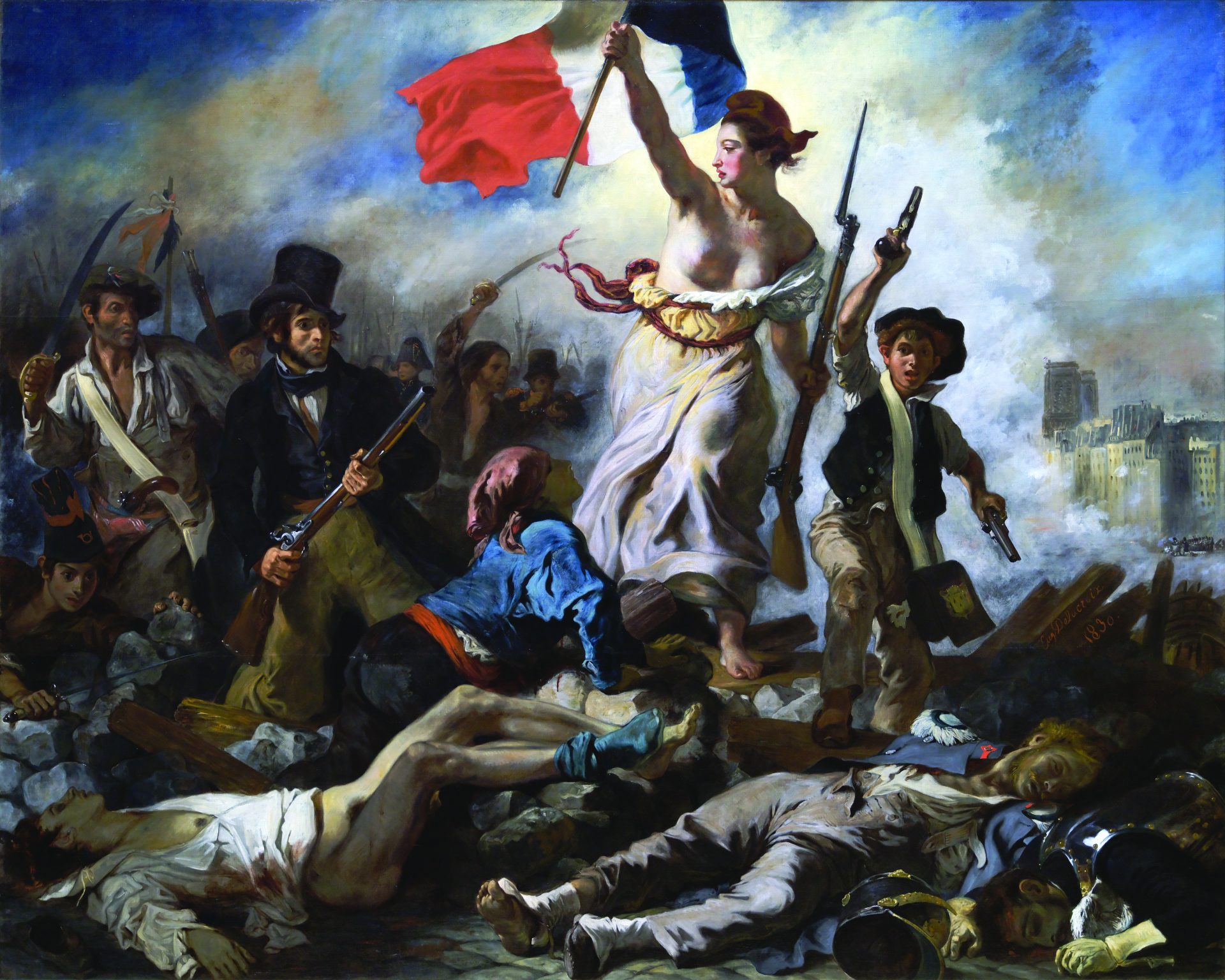
As I sit down to write this review of a book about persistent French cultural pathologies, Paris has just witnessed a mass march against the government of Socialist president François Hollande. On this self-styled “Day of Wrath,” one contingent of demonstrators sang a Holocaust-mocking ditty titled “Shoah-nanas,” made popular by the comedian Dieudonné; recently, France’s minister of the interior banned Dieudonné’s one-man show Le mur as an affront to “human dignity” for its allegedly anti-Semitic content. Dieudonné’s defenders sometimes claim that his performances are not anti-Semitic but merely anti-Zionist. The Paris demonstrators made it clear, however, that they have little use for such subtle distinctions, since immediately after their rendition of “Shoah-nanas” they began to chant “Juif, la France n’est pas à toi” (Jew, France is not for you)—a direct echo of anti-Semitic chants heard in the streets of Paris in the period described in Frederick Brown’s The Embrace of Unreason. Brown’s thorough and patient psychoanalysis of the French “soul,” which began in 2010 with For the Soul of France, continues here—at a time when, alas, the French penchant for xenophobic intolerance is once more of urgent topical interest.
Brown, the author of distinguished biographies of Gustave Flaubert and Émile Zola, is an accomplished and accessible cultural historian. His eye for the telling anecdote and colorful detail and seeming allergy to academic jargon make him an amiable and trustworthy guide to the dark side of the French psyche. In For the Soul of France, he used his deft Impressionist’s brush to embellish a revealing portrait of an anxious and melancholic nation. The argument was simple. Defeat in the Franco-Prussian War (1870–71) had plunged la Grande Nation into a deep depression. Elites differed as to the proper remedy and even the nature of the malady. Zola—after witnessing pilgrims crowding the shrine at Lourdes marking the spot where Bernadette Soubirous, a peasant girl of fourteen, had experienced a vision of the Virgin Mary—could only shake his head at the masses’ apparent expectation of a miraculous cure for France’s woes. The time had come, he felt, to “study and dramatize the endless duel between science and the longing for supernatural intervention.” In Zola’s dramatic confrontation between reason and religion, Brown discerned two “competing prescriptions for France’s recovery after the Franco-Prussian debacle of 1870–71.”
The Embrace of Unreason ostensibly picks up the story of France’s malaise where the previous book left off. Its subtitle, France, 1914–1940, suggests a clear and seamless continuity between the two works. This is somewhat misleading, however, for there is considerable overlap between the earlier book and this one (including extensive passages carried over verbatim). Indeed, The Embrace of Unreason actually begins, as did the earlier book, in the years that followed the Franco-Prussian War, and Brown devotes a good deal of space to figures who were covered at length in For the Soul of France, such as the nationalist writer Maurice Barrès and the would-be putschist general Georges Boulanger. The subtitle of The Embrace of Unreason should really be France, 1870–1940.
Perhaps the overlap and repetition arise from the subtle shift in Brown’s approach, which seeks here to describe unreason as a more seductive and visceral feature of French culture than had been the case in For the Soul of France. Although the earlier volume emphasized Zola’s vision of a clash of ideas, science scarcely figured in the book, and religion served mainly as an accompaniment to the main theme, which was the emergence of a tribal nationalism in a republic that also saw itself as the bearer of a universal message. Zola’s formulation actually articulated the fighting faith of the founders of the Third Republic, the regime that replaced Napoléon III’s Second Empire in 1870, after the Prussians toppled it. The founders naturally embraced Zola’s scripted role for them as righteous advocates of both the Enlightenment and the French Revolution, which they tended to collapse into one century-long battle against religious obscurantism and aristocratic oppression. The republican cause was thus identified with the heroic struggle for universal reason and human rights.
Brown is too shrewd a historian to have taken the Third Republic’s apologists at their word. In The Embrace of Unreason, he abandons the simplistic schema of a clash between reason and religion. The final separation of church and state in France in 1905 had made religion a less salient issue in any case. In this slightly revised analytical framework, the essential conflict occurs between universalism and particularism, or “tribalism,” as Brown calls it. He argues that the country’s post-1914 descent into “unreason” involved the rejection of Enlightenment-era claims of universal truth in favor of something more elemental, organic, visceral, and vital.
The interesting thing about the tribal sensibility Brown sketches out here is that it draws its vitality mainly from foreign rather than domestic sources—a dramatic turnaround for a culture that had spawned an intensely tribal nationalism in response to its loss in the Franco-Prussian War. By contrast, the demoralized political leaders and intellectuals whom Brown profiles here looked to France’s hereditary enemy Germany—and specifically Germany’s quasi-Romantic, decidedly tribal revolt against its own Kantian rationalist tradition—as the antidote to the poison of universal reason that had allegedly sapped the strength of postrevolutionary France. For Maurice Barrès, a pivotal figure in both of Brown’s volumes, France went astray when it sought to emulate Germany’s educational system and to place Kantian idealism at the heart of its message to the young. In Barrès’s view, if “French reason” had become “parched,” it had contracted that malady from the arid abstractions of Kantian philosophy, “uprooting” young students from their native soil and transporting them into a universalist void incapable of sustaining commitment to the ancestral homeland. Instead, Barrès promoted the “tribal” nationalism of General Boulanger, whom he adopted for a time as his hero and France’s potential savior.
But Barrès himself had been a Kantian in his youth. In one of the finer passages of the biographical-intellectual miniportraits at which Brown excels, we discover that before Boulanger, Barrès had adopted a very different hero, Auguste Burdeau, with whom he studied Kantian idealism as a lycée student. Burdeau later became a minister of the Third Republic that Barrès hoped Boulanger would overthrow; he would also serve as the model for Paul Bouteiller, the evil genius of Barrès’s most famous novel, Les déracinés (The Uprooted)—a character whom he castigates for deluding his students into believing that philosophy had “the seriousness of a religion.”
If Barrès is the central figure of the first part of The Embrace of Unreason, the soon-to-be-collaborationist writer Pierre Drieu La Rochelle occupies center stage in the second. Brown is not the first historian to have been fascinated by the prolific and protean author of Gilles: “Politically, he had worn as many hats as a well-furnished dandy . . . doffing them left and right to gain attention yet remain impenetrable.” Drieu certainly contained multitudes of apparent self-contradictions: He was an anti-Semite who married a wealthy Jew, divorced her, but in the end used his Nazi connections to save her from the death camps. As he put it in Gilles,“French reason was the passionate, proud, furious twelfth century splurging itself in epics and cathedrals.” Descartes, the father of French reason in the modern or “universal” sense that Drieu rejected, had put an end to the carefully wrought organic unity of the Middle Ages with his methodical doubt, so that architects no longer built cathedrals that expressed the “instincts” of a “race” but only “office buildings, boxes for rent, public conveniences.”
Here, the collaborator who would end his life as a suicide when the “primitive vitality” of the Germans failed him touches on a point that Brown’s panoramic survey misses. What if Europe’s descent into “unreason” was not so much an abandonment of reason as a working out of contradictions inherent in reason itself? As Max Horkheimer and Theodor Adorno were the first to argue in Dialectic of Enlightenment (1944), the triumph of scientific, “instrumental” reason enabled man to dominate nature and transform the conditions of his existence in ways that his subjective and social reason could not cope with. The cultural pathologies that Brown documents in such vibrant detail may thus be merely the surface manifestations of a deeper disorder within reason itself. In this view, “unreason” is not the antithesis of reason; instead, it emerges much more clearly as a category created by reason to encompass the undesired consequences of its implacable but eternally troubled progress.
In spite of the limitations that Brown seems to have imposed on the conceptual reach of his narrative, The Embrace of Unreason remains a lively and compelling work of cultural history. Readers will be grateful for Brown’s sure-handed navigation through the thickets of French intellectual reaction. Although Brown’s method precludes investigation of the social and economic changes that underlie the cultural malaise he portrays, his fluent style and confident grasp of the period make it a pleasure to explore this unsettling terrain in his company.
Arthur Goldhammer is a senior affiliate of the Center for European Studies at Harvard University. He is the translator of more than 120 books from French and writes widely on French history, culture, and politics.






